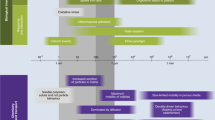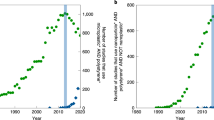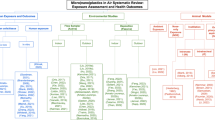Abstract
Nanoplastic particles are inadequately characterized environmental pollutants that have adverse effects on aquatic and atmospheric systems, causing detrimental effects to human health through inhalation, ingestion and skin penetration1,2,3. At present, it is explicitly assumed that environmental nanoplastics (EnvNPs) are weathering fragments of microplastic or larger plastic debris that have been discharged into terrestrial and aquatic environments, while atmospheric EnvNPs are attributed solely to aerosolization by wind and other mechanical forces. However, the sources and emissions of unintended EnvNPs are poorly understood and are therefore largely unaccounted for in various risk assessments4. Here we show that large quantities of EnvNPs may be directly emitted into the atmosphere as steam-laden waste components discharged from a technology commonly used to repair sewer pipes in urban areas. A comprehensive chemical analysis of the discharged waste condensate has revealed the abundant presence of insoluble colloids, which after drying form solid organic particles with a composition and viscosity consistent with EnvNPs. We suggest that airborne emissions of EnvNPs from these globally used sewer repair practices may be prevalent in highly populated urban areas5, and may have important implications for air quality and toxicological levels that need to be mitigated.
This is a preview of subscription content, access via your institution
Access options
Access Nature and 54 other Nature Portfolio journals
Get Nature+, our best-value online-access subscription
$29.99 / 30 days
cancel any time
Subscribe to this journal
Receive 12 print issues and online access
$259.00 per year
only $21.58 per issue
Buy this article
- Purchase on Springer Link
- Instant access to full article PDF
Prices may be subject to local taxes which are calculated during checkout





Similar content being viewed by others
Data availability
The datasets generated and analysed in this work are available for download as a zip file from https://doi.org/10.4231/XR71-ZM27. Datasets are provided for Figs. 2–5 and Supplementary Figs. 3, 5 and 7–10. Supplementary information is available in the online version of the paper. Correspondence and requests for materials should be addressed to A.L.
References
Schirinzi, G. F. et al. Cytotoxic effects of commonly used nanomaterials and microplastics on cerebral and epithelial human cells. Environ. Res. 159, 579–587 (2017).
Prata, J. C., da Costa, J. P., Lopes, I., Duarte, A. C. & Rocha-Santos, T. Environmental exposure to microplastics: an overview on possible human health effects. Sci. Total Environ. 702, 134455 (2020).
Lehner, R., Weder, C., Petri-Fink, A. & Rothen-Rutishauser, B. Emergence of nanoplastic in the environment and possible impact on human health. Environ. Sci. Technol. 53, 1748–1765 (2019).
Gigault, J. et al. Nanoplastics are neither microplastics nor engineered nanoparticles. Nat. Nanotechnol. 16, 501–507 (2021).
Cured-In-Place Pipe (CIPP) Market Size, Share, Trend, Forecast, and Competitive Analysis: 2020–2025. Report No. SRCE108; 1–273 (Stratview Research, 2019).
Peng, J., Wang, J. & Cai, L. Current understanding of microplastics in the environment: occurrence, fate, risks, and what we should do. Integr. Environ. Assess. Manag. 13, 476–482 (2017).
Bucci, K., Tulio, M. & Rochman, C. M. What is known and unknown about the effects of plastic pollution: a meta‐analysis and systematic review. Ecol. Appl. https://doi.org/10.1002/eap.2044 (2020).
Akdogan, Z. & Guven, B. Microplastics in the environment: a critical review of current understanding and identification of future research needs. Environ. Pollut. 254, 113011 (2019).
Wu, P. et al. Environmental occurrences, fate, and impacts of microplastics. Ecotoxicol. Environ. Saf. 184, 109612 (2019).
Wlasits, P. J., Stoellner, A., Lattner, G., Maggauer, K. & Winkler, P. M. Size characterization and detection of aerosolized nanoplastics originating from evaporated thermoplastics. Aerosol Sci. Technol. 56, 176–185 (2022).
Chen, G., Feng, Q. & Wang, J. Mini-review of microplastics in the atmosphere and their risks to humans. Sci. Total Environ. 703, 135504 (2020).
Ra, K. et al. Considerations for emission monitoring and liner analysis of thermally manufactured sewer cured-in-place-pipes (CIPP). J. Hazard. Mater. 371, 540–549 (2019).
Noh, Y. et al. Emergency responder and public health considerations for plastic sewer lining chemical waste exposures in indoor environments. J. Hazard. Mater. 422, 126832 (2022).
Matthews, E., Matthews, J. & Eklund, S. NASSCO CIPP Emissions Phase 2: Evaluation of Air Emissions from Polyester Resin CIPP with Steam Cure. Final Report (NASSCO, 2020).
Hong, Z. et al. Characteristics of atmospheric volatile organic compounds (VOCs) at a mountainous forest site and two urban sites in the southeast of China. Sci. Total Environ. 657, 1491–1500 (2019).
Teimouri Sendesi, S. M. et al. An emerging mobile air pollution source: outdoor plastic liner manufacturing sites discharge VOCs into urban and rural areas. Environ. Sci. Process. Impacts 22, 1828–1841 (2020).
Teimouri Sendesi, S. M. et al. Worksite chemical air emissions and worker exposure during sanitary sewer and stormwater pipe rehabilitation using cured-in-place-pipe (CIPP). Environ. Sci. Technol. Lett. 4, 325–333 (2017).
Hinds, W. C. in Aerosol Technology: Properties, Behavior, and Measurement of Airborne Particles 46–48 (Wiley, 1999).
Initial list of hazardous air pollutants with modifications (United States Environmental Protection Agency, 2022). https://www.epa.gov/haps/initial-list-hazardous-air-pollutants-modifications
NSCEP. An Exposure and Risk Assessment for Benzo[a]pyrene and Other Polycyclic Aromatic Hydrocarbons. Report No. EPA-44074-85-020 (NSCEP, 1982).
Foster, P. M., Mylchreest, E., Gaido, K. W. & Sar, M. Effects of phthalate esters on the developing reproductive tract of male rats. Hum. Reprod. Update 7, 231–235 (2001).
Lee, A. K. Y. et al. Formation of light absorbing organo-nitrogen species from evaporation of droplets containing glyoxal and ammonium sulfate. Environ. Sci. Technol. 47, 12819–12826 (2013).
Ortiz-Montalvo, D. L., Schwier, A. N., Lim, Y. B., McNeill, V. F. & Turpin, B. J. Volatility of methylglyoxal cloud SOA formed through OH radical oxidation and droplet evaporation. Atmos. Environ. 130, 145–152 (2016).
Bain, R. M., Pulliam, C. J., Thery, F. & Cooks, R. G. Accelerated chemical reactions and organic synthesis in Leidenfrost droplets. Angew. Chem. Int. Ed. 55, 10478–10482 (2016).
Petters, S. S. et al. Volatility change during droplet evaporation of pyruvic acid. ACS Earth Space Chem. 4, 741–749 (2020).
Nguyen, T. B. et al. Formation of nitrogen-and sulfur-containing light-absorbing compounds accelerated by evaporation of water from secondary organic aerosols. J. Geophys. Res.: Atmos. 117, D01207 (2012).
Marsh, B. M., Iyer, K. & Cooks, R. G. Reaction acceleration in electrospray droplets: size, distance, and surfactant effects. J. Am. Soc. Mass. Spectrom. 30, 2022–2030 (2019).
Laskin, J. et al. Molecular selectivity of brown carbon chromophores. Environ. Sci. Technol. 48, 12047–12055 (2014).
Reid, J. P. et al. The viscosity of atmospherically relevant organic particles. Nat. Commun. 9, 956 (2018).
Zhou, X.-X., Liu, R., Hao, L.-T. & Liu, J.-F. Identification of polystyrene nanoplastics using surface enhanced Raman spectroscopy. Talanta 221, 121552 (2021).
Schoukens, G., Martins, J. & Samyn, P. Insights in the molecular structure of low- and high-molecular weight poly(styrene-maleic anhydride) from vibrational and resonance spectroscopy. Polymer 54, 349–362 (2013).
Dhez, O., Ade, H. & Urquhart, S. G. Calibrated NEXAFS spectra of some common polymers. J. Electron Spectrosc. Relat. Phenom. 128, 85–96 (2003).
Laskin, A., Moffet, R. C. & Gilles, M. K. Chemical imaging of atmospheric particles. Acc. Chem. Res. 52, 3419–3431 (2019).
Najafi, M. et al. Evaluation of Potential Release of Organic Chemicals in the Steam Exhaust and Other Release Points During Pipe Rehabilitation Using the Trenchless Cured-In-Place Pipe (CIPP) Method (NASSCO, 2018).
Nuruddin, M. et al. Evaluation of the physical, chemical, mechanical, and thermal properties of steam-cured PET/polyester cured-in-place pipe. J. Compos. Mater. 53, 2687–2699 (2019).
Ra, K. et al. Critical review: surface water and stormwater quality impacts of cured-in-place pipe repairs. J. Am. Water Works Assoc. 110, 15–32 (2018).
Li, X. et al. Outdoor manufacture of UV-cured plastic linings for storm water culvert repair: chemical emissions and residual. Environ. Pollut. 245, 1031–1040 (2019).
US Occupational Safety and Health Administration Citation and Notification of Penalty, Inspection Number 1274028. Report No. 0524200 (US Department of Labor, 2017).
LeBouf, R. F. & Burns, D. A. Health Hazard Evaluation Report: Evaluation of Exposures to Styrene During Ultraviolet Cured-in-Place-Pipe Installation. Report No. 2018-0009–3334 (US National Institute of Occupational Safety and Health, Centers for Disease Control and Prevention, 2019).
Cure-in-Place Pipe (CIPP): Additional Considerations for Municipalities (California Department of Public Health, 2017).
CIPP Safety Alert (California Department of Public Health, 2018).
Lin, P., Fleming, L. T., Nizkorodov, S. A., Laskin, J. & Laskin, A. Comprehensive molecular characterization of atmospheric brown carbon by high resolution mass spectrometry with electrospray and atmospheric pressure photoionization. Anal. Chem. 90, 12493–12502 (2018).
Laskin, A., Cowin, J. P. & Iedema, M. J. Analysis of individual environmental particles using modern methods of electron microscopy and X-ray microanalysis. J. Electron Spectrosc. Relat. Phenom. 150, 260–274 (2006).
Anger, P. M. et al. Raman microspectroscopy as a tool for microplastic particle analysis. Trends Anal. Chem. 109, 214–226 (2018).
Moffet, R. C., Tivanski, A. V. & Gilles, M. K. in Fundamentals and Applications in Aerosol Spectroscopy (eds Signorell, R. & Reid, J. P.) Ch. 17 (Taylor and Francis, 2010).
Moffet, R. C., Henn, T., Laskin, A. & Gilles, M. K. Automated chemical analysis of internally mixed aerosol particles using X-ray spectromicroscopy at the carbon K-edge. Anal. Chem. 82, 7906–7914 (2010).
Acknowledgements
This work was supported by the US National Science Foundation (grant nos. CBET-1624183 and CBET-2129166 (A.J.W. group), and CBET-2107946 (A.L. group)), the National Science Foundation Graduate Research Fellowship Program (grant no. DGE-1333468 (A.C.M.)) and the Purdue University Ross Fellowship program (B.N.P., S.A.L.S. and Y.N.). Any opinions, findings and conclusions or recommendations expressed in this material are those of the author(s) and do not necessarily reflect the views of the National Science Foundation. The CCSEM–EDX, HRTEM and SERS analyses, with guidance from N. Lata and Z. Cheng, were performed at the Environmental Molecular Sciences Laboratory, a National Scientific User Facility sponsored by OBER at PNNL. PNNL is operated by the US Department of Energy by the Battelle Memorial Institute under contract DE-AC06-76RL0. STXM–NEXAFS analyses were performed at beamline 5.3.2 of the Advanced Light Source at Lawrence Berkeley National Laboratory (LBNL), with guidance from D. Kilcoyne, M. Marcus and D. Shapiro. LBNL is supported by the Director, Office of Science, Office of Basic Energy Sciences of the US Department of Energy under contract DE-AC02-05CH11231. STXM maps of particles were also acquired at the Canadian Light Source (CLS), with guidance from J. Wang. CLS is supported by the Canada Foundation for Innovation, Natural Sciences and Engineering Research Council of Canada, the University of Saskatchewan, the Government of Saskatchewan, Western Economic Diversification Canada, the National Research Council Canada and the Canadian Institutes of Health Research.
Author information
Authors and Affiliations
Contributions
A.C.M., J.M.T. and A.L. conceptualized the framework, experiments and analytical methodologies of the study. Y.N., S.M.T.S., B.E.B., J.A.H. and A.J.W. conducted field studies and provided samples of the CIPP waste condensates. A.C.M., C.P.W. and B.N.P. performed the HPLC–HRMS measurements and analysed the data. J.M.T. and F.A.R.-A. analysed individual particles using SEM and STXM. S.A.L.S. performed the TEM analysis of heated particles. S.C. assisted with SEM experiments and R.C.M. assisted with STXM experiments and instrument operation. B.T.O’C. and P.Z.E.-K. performed the SERS analysis. A.C.M. and A.L. integrated the experimental datasets and wrote the manuscript, and all authors contributed its review and editing. A.J.W. and A.L. secured grant support for this study and managed the project.
Corresponding author
Ethics declarations
Competing interests
A.J.W., J.A.H., B.E.B. and S.M.T.S. are named in a patent application (PCT application no. PCT/US18/28173) filed 18 April 2018 by the Purdue Research Foundation. The patent application pertains to the technologies for capturing CIPP waste condensates investigated in this study. The invention was developed with support from the US National Science Foundation (grant CBET-1624183). The remaining authors declare no competing interests.
Peer review
Peer review information
Nature Nanotechnology thanks the anonymous reviewers for their contribution to the peer review of this work.
Additional information
Publisher’s note Springer Nature remains neutral with regard to jurisdictional claims in published maps and institutional affiliations.
Supplementary information
Supplementary Information
Supplementary Notes 1–13 and references.
Supplementary Video 1
A video of the discharged waste plume adjacent to the oak tree. Taken by A.J.W.
Rights and permissions
Springer Nature or its licensor holds exclusive rights to this article under a publishing agreement with the author(s) or other rightsholder(s); author self-archiving of the accepted manuscript version of this article is solely governed by the terms of such publishing agreement and applicable law.
About this article
Cite this article
Morales, A.C., Tomlin, J.M., West, C.P. et al. Atmospheric emission of nanoplastics from sewer pipe repairs. Nat. Nanotechnol. 17, 1171–1177 (2022). https://doi.org/10.1038/s41565-022-01219-9
Received:
Accepted:
Published:
Issue Date:
DOI: https://doi.org/10.1038/s41565-022-01219-9
This article is cited by
-
Toxicological Effects of Secondary Air Pollutants
Chemical Research in Chinese Universities (2023)



